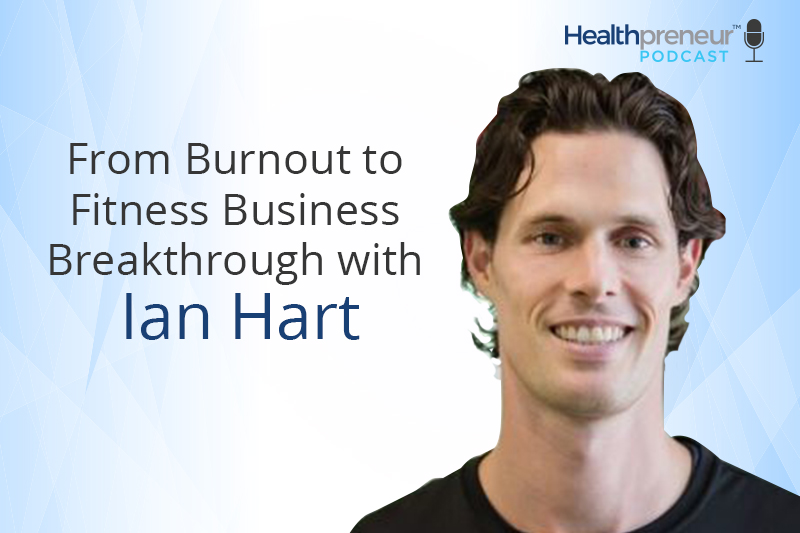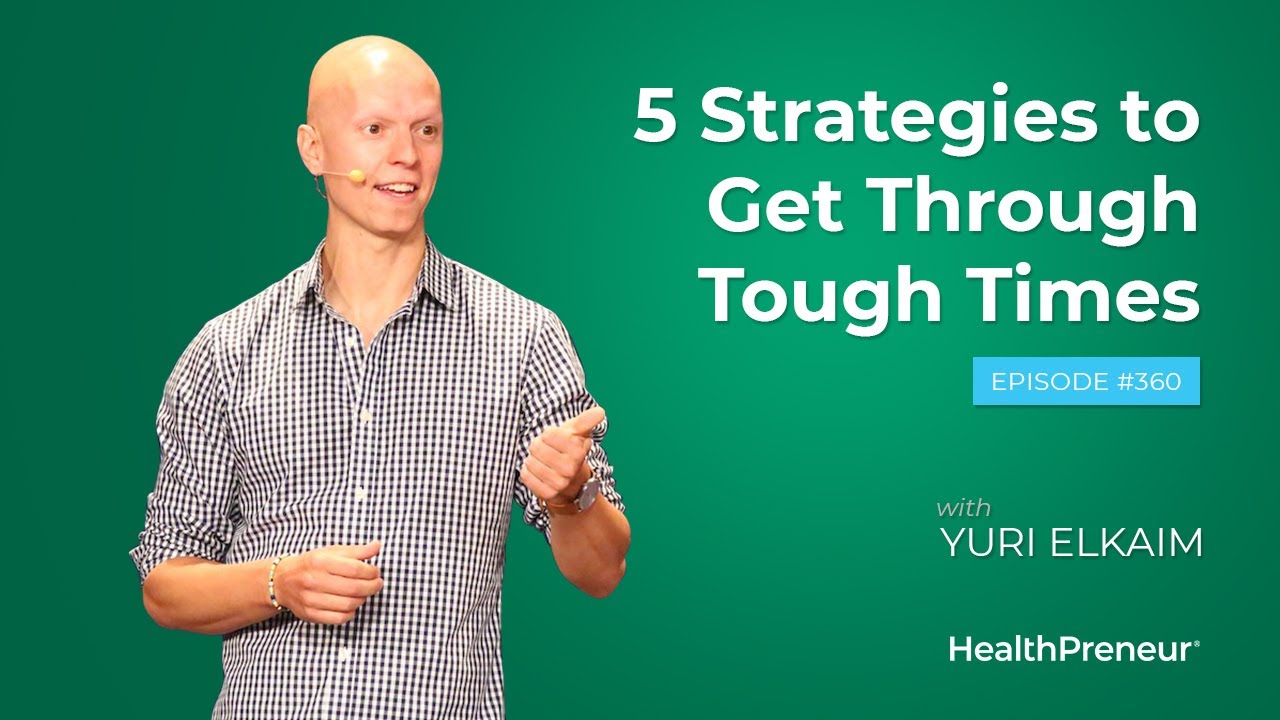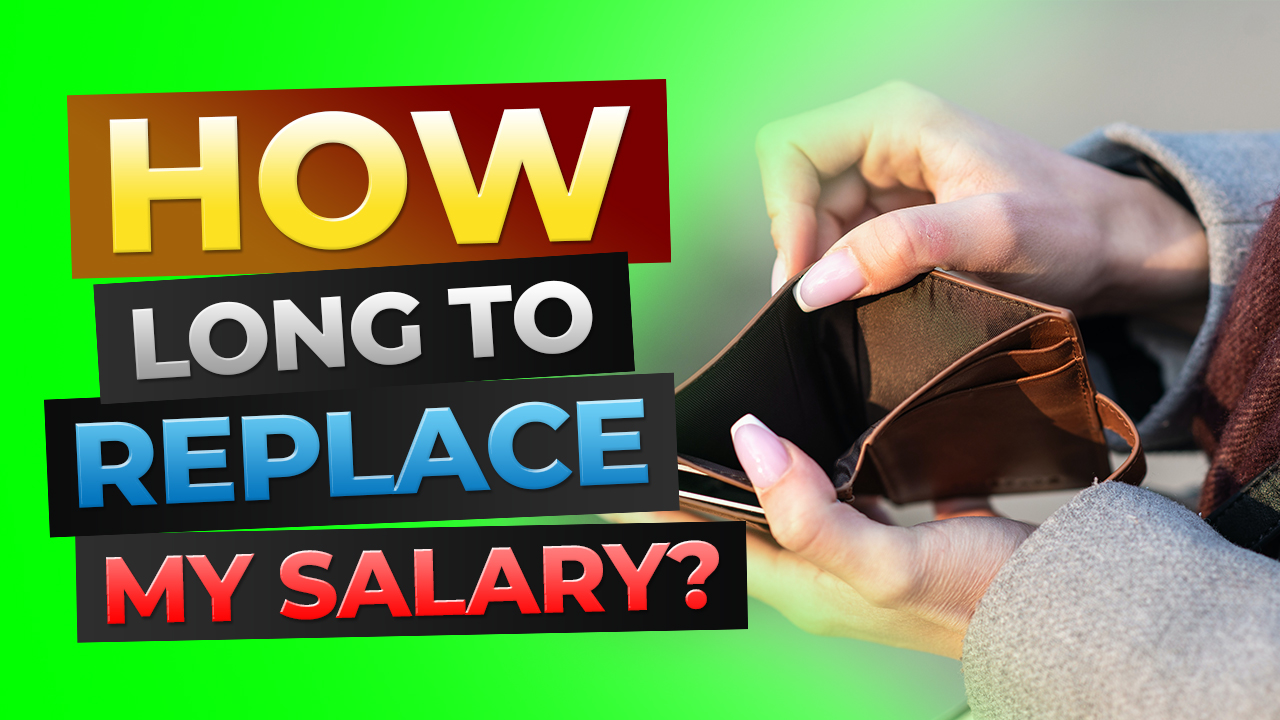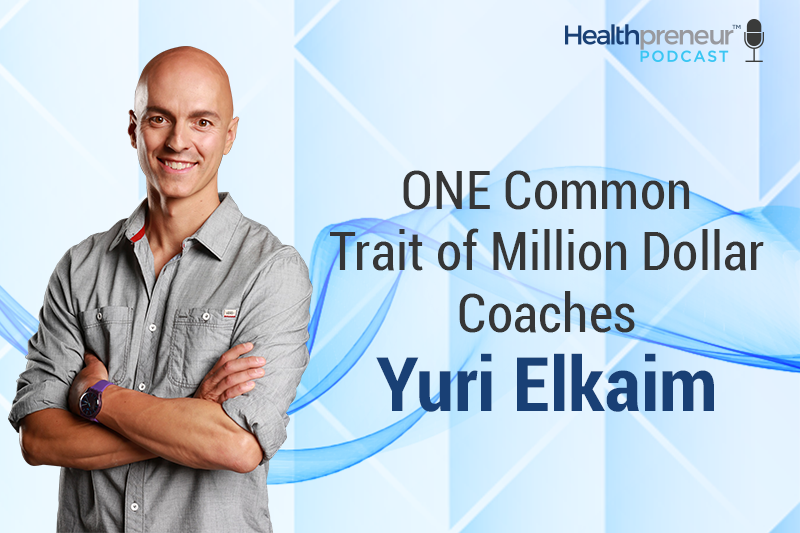7 Lessons From My 7-Figure Health Business
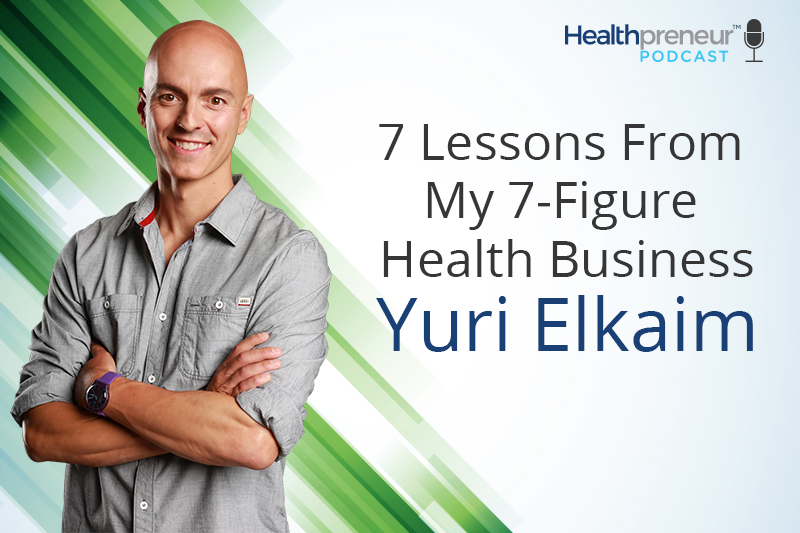
How’s it going, Healthpreneurs? It’s time for my weekly solo round where I give you some insider lessons based upon my own personal experience. Today, I will be sharing with you seven lessons that I’ve learned from my 7-figure business. If you’re looking to hit 7-figures, or you already have and want to stay consistent in your growth, tune in.
To have a thriving business, you must know your vision. Your strategy can change – as I’ve mentioned in previous episodes – but your overall vision should remain crystal clear and constant. With that in place, the things that push you over the 6-figure threshold include interacting with your clients, selling what people want, knowing your numbers, and knowing your business model.
The biggie is having a predictable sales process. Without that, your business will fall apart. The seven lessons I’ve learned from my 7-figure businesses all came from taking the wild ride that is entrepreneurship – and man, has it been fun. Yes, we learn lessons, but we’re permanently changed for the better, too.
In This Episode I discuss:
1:00 – 4:00 – Clarify your vision and engage and interact with clients
4:00 – 7:00 – Sell what people want, give them what they need, and know your numbers
7:00 – 13:30 – Know your business model and predictable sales process
13:30 – 18:00 – Always add value, know it’ll be a challenge, and enjoy the ride
18:00 – 12:30 – How being an entrepreneur changes you: Growth, contribution, freedom
Transcription
Today I’m going to be sharing seven lessons from my The 7-Figure Health Business with you.
If you want to grow your business or if you already have a successful business or if you’re just getting started, these are some lessons I’ve learned over the past 13 years with my business online, that I think will really give you some great insight and clarity about what you want to avoid and maybe what you want to do a little bit more of.
Without any further ado, shall we just jump right in? Is that okay with you?
Clarify your vision and engage and interact with clients
1. Clarity of Vision
All right. Here we go. The first lesson is you have to clarify what you want to achieve. That’s the starting point for everything, right?
Having that clear vision is the guiding light. It’s the North Star for everything you do. We talked about how even though your strategy can change, what you want to achieve should be set in stone. Now again that can change over time as well. Like you achieve something and then you want to achieve something else or maybe there’s a bit of an offshoot, but you want to have a clear vision of what you want to achieve whether that’s from a big perspective or even what you want to achieve on a daily basis. Okay? Clarity is massively important.
Just like pilots do not leave the terminal without a flight plan, without knowing where they’re going, you should not be doing anything in your business without knowing exactly where you’re going. That’s the first thing.
2. Engage With Your Customers
Second lesson is you want to engage with your customers or your clients as often as possible. This is where a lot of let’s call them Fortune 500 company CEOs drop the ball big time because they get to a point where they’re so removed from their customers, so removed from the marketplace, that they’re so disconnected from it. They’re sitting in their ivory tower looking at spreadsheets and numbers and they kind of forget that they’re dealing with people.
I think the benefit of having a coaching-based business is you’re forced to engage with your clients all the time, which is amazing. If you’re somebody who is a bit of a recluse and you don’t enjoy interacting with people, that’s totally fine.
You’ve got more of a product-based business and that’s the way you want to run things, totally cool as well, but there will come a point where either you’re not going to feel as fulfilled as you want or your customers don’t feel appreciated because you never interact with them.
Interact with them doesn’t mean send them promotional emails several days a week. It doesn’t mean the typical communication that we send out out via the internet, right?
It’s things like sending people a personal thank you video or sending them a message on Facebook to let them know that you appreciate their business. Little things like that can make a big difference. Even at the minimum, if you’ve got a Facebook group, get in the group and engage with them. This is something that I’m guilty of.
We have our Healthpreneur Facebook group. We’ve got several thousand people on that, and I’m not as active in there as maybe I could be, but again I’m more active on Instagram to be honest with you. If you want to hang out and interact with me, follow me on Instagram. I’m at @healthpreneur1. That’s probably where we’ll have the most conversation.
Whatever your platform is, just choose that platform to engage with your customers or clients.
Sell what people want, give them what they need, and know your numbers
3. Sell People What They Want
Third lesson, sell people what they want instead of what they need. Most people need support, mindset and all that kind of stuff, right? Everything between the ears, limiting beliefs, all that stuff that holds people back. That’s what they need to succeed. It doesn’t matter what you’re selling. Everybody needs that.
That’s the biggest difference between those people that do succeed and those people that don’t is what’s happening between the ears. That’s what people need the most help with. Do they want to buy that? No, because they’ve heard it a thousand times.
It’s not sexy. It’s not novel. What they want are the tactics, the strategies, the swipe files, the done for you, whatever. These are the things where we want to meet people where they’re at. Sell them the thing they want. Sell them the weight loss system, but support the hell out of them on the backend with the stuff they need to actually deploy what it is they bought. That’s a big thing.
I’ve spent a long time struggling with this because I think a lot of us health experts come from a place where we’re kind of eternal optimists. We’re like, “Oh, this is the way it should be. This is what people should want to buy,” but we’re going to shit all over ourselves as Tony Robbins says, right?
We have to give people what they want, not what we think they want. You really have to be tuned into the marketplace. Yeah, and start there. Sell them what they want. Give them want they need.
4. Know Your Numbers
Fourth lesson is know your numbers. Listen, I’m not a numbers guy. I procrastinate even to this day big time with my accountants. I hate looking through spreadsheets and tracking down specific transactions. That stuff drives me crazy, but it has to get done. Now that’s an extreme example, but even if we just back it up a little bit to knowing your numbers, we talked about this on a previous episode, is you have to measure the most important metrics in your business.
I know exactly the most important numbers in our business and I track them at minimum every week. I do a whole reporting. We have a scorecard that I update and look at every single Monday, and then we’ve got a couple different things that are filled in from our team members. At the very minimum, I have a financial check in every Friday where I look at my personal bank stuff, my business stuff. Then Mondays I review our scorecard from the previous week. You have to understand your numbers. First of all, you have to identify what those critical numbers are and there should not be a thousand of them. There might be a handful.
You have to make sure that they’re meaningful to moving your business forward, and then look at those because those the going to be the indicators of how well your business is doing. It’s really important.
Know your business model and predictable sales process
5. Know Your Business Model
Number five is identifying and perfectly one main process that attracts and converts new business. This is your business model. This is when people say how do you attract new clients, if you don’t have a solid answer to that and by solid answer I mean “well, we have this automated system that I don’t really do much with and it attracts clients,” that’s kind of the ideal answer.
Most health experts that we talk with, their answer is, “I don’t really have one or some clients refer me some new business,” but it’s not predictable. Okay? That’s the biggest problem we continue to see in all of the businesses that we help is there’s no clearly defined business model where you have a defined input and then there’s a predictable output. By that I mean what we help our clients deploy as I’ve mentioned probably a thousand times now is the perfect client pipeline.
It’s a four step process that walks you through exactly how to automate most of your marketing so that even when you’re sleeping, you can have clients enrolling or busy applying to speak with you and then you can enroll them a lot more easily and predictably. Every single month you can have tens of clients or even more working with you at a very high level and paying you premium price to do that. That’s a much more attractive position to be in than posting on social media haphazardly. Maybe someone will take your baits, all that kind of stuff. When I mean predictable, here’s the thing. Our whole perfect client pipeline is built on the premise that we have to go out and pay to acquire clients.
What that means is you have to be … Two things. You have to have a process n place and second, you have to have the courage to be able to say, “Okay. Listen, I’m going to take a risk.” That’s essentially what this is. “I’m going to invest $500 into Facebook ads and we’re going to see what happens.” With our guidance, I mean it’s amazing what can happen. We actually just had one of our clients Dan post yesterday morning about … He just kind of did a little recap of the last couple months just so everyone else in the group, in our Health Business Accelerator group, have some context.
He’s like, “Hey, guys. Just want to give you some ideas here about what’s been happening in the last couple weeks.” He said that he had spent … I think he had an initial test of $500. He had no result. Like no profit from that, right? That can happen sometimes. Then he said the next round he spent $500. He made $1,500 profit. Then he had a next round of testing. Spent $500 again. He had another $1,500 in profit plus a number of new calls coming in that week. The profit potential there, the ROI, was four or five to one. The whole idea here is that he was saying, he’s like, “Guys, just follow the process, know your numbers, and keep practicing, right? Just keep at it.”
He was getting calls booked for $33 a call, which is phenomenal considering that people are jumping through a number of hoops before they can even book a call with him. $33 per call to jump into a program that is priced … I think it’s priced at about $1,997, $2,000 or so. When you have that type of process built out, it’s amazing what can happen. I tell our clients all the time like I will not even work with people in our Luminaries Mastermind, which is our mastermind where we help people go from six to seven figures, if they don’t have a predictable process in our business for attracting clients or customers.
Because if you don’t, here’s what the alternative is is you run a promotion machine, is every single day you’re running promotions. “Hey, buy this. Buy this. Buy this other person’s stuff. Buy this stuff.” It’s exhausting. It kills your list. It kills the goodwill you have with your audience, and it’s not a predictable model. It’s hope and pray. It’s shoot and spray. All these different terms you can use.
The biggest thing I want to leave you with with respect to this one lesson is if you don’t have a predictable, automated, when I say automated, I’d say the vast majority of that process is automated, so 90% of it is automated, so you have for instance Facebook ads or YouTube ads putting your message out in front of your ideal audience, and as a result, attracting them into the next step, which in our case is a webinar. Then from there, getting people to fill out an application and then jump on the phone with you. If you don’t have that built out, like you’re toast. I’m telling you. You’re struggling.
I tell people, “Listen, don’t even go in and don’t even waste time on social media. Don’t be on Instagram. Don’t do anything else until you have this built out.” Then people ask me, “Okay, Yuri. Well, I see you on Instagram. I see you’ve got a podcast. I see you’re doing stuff on YouTube. What’s going on? You’re not congruent with your message.” I have to remind them. I’m like, “Hey, guys. You have to have the sales process built out before anything else. I’ve built out the process two years ago. Okay?” Now I’ve got some more time to start spending on other things, right? I can spend more time on Instagram and do other things like that.
But if you don’t have a predictable sales process in your business, nothing else you are doing is worth your time. Nothing. I’m dead serious about this. Do not write another article. Don’t write another email. Do not get another phone call. Don’t do another interview. Don’t post another thing on social media until you have your perfect client pipeline built out. I’m dead serious about this. I’m very passionate about this because I’m sick and tired of seeing well-intentioned, amazingly passionate health experts, health and fitness experts, struggle because they don’t have this predictability in their business. It will cripple you.
Okay? Now if you want help with this specifically, this is our bread and butter. This is what we do every single day. This is how we’ve built our business, Healthpreneur, to more than seven figures in just over a year. This is exactly how we help our clients go from zero to hero or scaling what they already have. The beautiful thing about this is that it levels the playing field. You don’t have to have a following online. You don’t have to have all these accreditations. You just have to be able to produce a result for someone. If you want help with this, go through our training, healthpreneurgroup.com/training.
If it resonates with you, then book a call to speak with us. We’ll get you on the right path to move your business forward. If you want our help, we can talk about that as well. Okay? That’s a long-winded answer. It’s a long-winded points for number five.
Always add value, know it’ll be a challenge, and enjoy the ride
6. Always Add Value
The sixth lesson from my seven figure businesses is always be adding value. Always be adding value. This podcast is an example of adding value. Your Facebook ads should be valuable in and of themselves. If someone doesn’t click on the link in your ad, they should still be like, “That was a useful 30 seconds of my time.” Every touch point you have with an audience should be valuable.
The webinar people attend, the phone call they get on with you, everything should be about adding value before asking for anything in return. It doesn’t matter what you’re selling or what your model is. That is a commandment. That’s a big one.
7. Buckle Up And Enjoy The Ride
Number seven, the seventh lesson is buckle up, enjoy the ride, and never give up. I say buckle up because if you’ve ever been on a roller coaster, that’s essentially what business is like. If you’ve been in business for anymore anytime, you know what I mean. You’ve probably heard some great interviews on this podcast from people who’ve been around for a while. Other people that are a little bit more novice in their business.
I can tell you without a shadow of a doubt there’s not a single person I’ve ever met who had it easy, smooth sailing all the way through. That does not exist. The dilemma, the challenge in 2018 is that social media highlights the destination. It doesn’t highlight the journey. You have to be aware of that. When people are showing you the shiny cars and the private jets and how many clients they’ve enrolled or wherever they’re traveling, all this kind of stuff, they’re not showing you what went in to get that. I want to make a much more conscious effort, at least with respect to what I’m sharing on social, about what is involved in the process.
The hardships, the lessons learned, because it’s not always easy. There are times where you’re not going to sleep well. There are times where you’re going to require massive amounts of courage to continue moving forward. There are times where you’re going to have to say how much money am I willing to lose to make this work. If you’re not cut out for that, if you can’t stomach that, you probably should get a job working for somebody else. Because I will tell you, there is nothing more rewarding than building your own legacy, building your own empire, but that does not happen on the back of easy streets. It happens sadly through struggle.
I don’t want to make it sound like everything has to be hard and challenging and there’s suffering involved and everything because there doesn’t have to be. But I think if you’re not realistic about the fact that there are going to be times that are really going to challenge you, just like when you workout, you can give up or you can do a couple more reps. It’s the same thing in business. How you do anything is how you do everything. If you give up when the going gets tough, if you are not able to push through those limiting beliefs, if you don’t feel that you’re worth what it is you’re selling or what it is you’re charging, all these things are going to hold you back.
How being an entrepreneur changes you: Growth, contribution, freedom
I can tell you that the number one traits of successful entrepreneurs is courage. That’s really what it boils down to. What is courage? Courage is the ability to move through fear. That’s all it is. Fear never goes away. Life doesn’t get easier. Business doesn’t necessarily get easier. I mean relatively maybe it does. You just get better. As a result of getting better and being able to handle more and bigger things, subjectively things do get a bit easier. You can take on bigger problems, bigger challenges, and solve those for yourself, for your clients, for your business. That’s what this journey’s all about.
We kind of start on the kiddie roller coaster, right? The one that doesn’t require like heavy duty seat belts. Then as we get a little bit more seasoned, we’re like, “Okay. I can handle the bigger ones, right? I can handle the one with the loops, the one with the crazy drops,” and that’s pretty much how life is and that’s how business is. I can tell you firsthand from experience that it’s the most rewarding ride to be on other than being parents. Having your own business and pushing through the challenges. I’m going to add one more caveat.
Other than being parents, other than pursuing professional athletics because that in and of itself is incredible, building your own business and really transforming people’s lives, building a team in the process, is you will learn so much about yourself. You will grow so much in the process that you’ll connect with people 10 years down the road who are working in nine to five jobs, who you knew from high school or college, they will be the same people. They will look at you and be like, “You’re not the same person.” That’s a very good compliment because it’s all about growth. Entrepreneurs I believe really value growth, contribution, and freedom.
That’s what we’re all here to do. Those are the seven lessons from my 13 plus years building a few seven figure businesses in the health and fitness space. I hope you found them helpful.
Once again, listen, my goal is to help you not have to suffer. My goal is to help you move from suffering to success, from mediocre results to amazing results. Remember, when I say that, I’m not saying it’s not going to be easy, right? We’re still going to get on the roller coaster, but the difference is that we’re going to go on the roller coaster together. I’m going to walk you through that. I’m going to run you through that.
We’re going to go through the ups and downs together. Having that really makes a big difference. I’ve had numerous coaches and supports over my life. It’s probably the only reason that I’m here even sharing this with you. If you think you can do it on your own, it’s not going to happen because I did that and it didn’t happen. I know a lot of people who didn’t really do it on their own. There’s very few people. If you’ve listened to any of the interviews in this podcast, a lot of them have said, “I wish I had found a mentor or a coach and I wish I had found them sooner.” Bar none. Like every single person that I know who’s successful will say the same thing.
That’s why I invest continually every single year anywhere between $50 to $150,000 in my own growth and development, coaching programs, masterminds, all sorts of stuff. I really, really encourage you to do the same because this is your business, right? This is your life. This is your legacy. It’s not a hobby. If it’s a hobby, why even bother, right? Why even go through this if it’s a hobby? Go in. Jump in the pool or don’t go to the pool at all, right? Don’t stand on the first step. Dive in. Don’t even play. That’s the way it is. It’s black or it’s white. There’s no room in this world, there’s no room in this competitive marketplace for dabblers.
You have to commit to mastering. You have to commit to mastering what you do, how you help your clients, your ability to influence people, your ability to sell, to market, all that good stuff, right? You have to be able to put in the time and effort to make that a reality.
I could talk about this forever obviously, but I will leave it at that.
Again if you want our help in helping you move your business forward, then start off by going through our free training over at healthpreneurgroup.com/training.
In the meantime, thank you so much for joining me. Continue to get out there, be great, do great, and I’ll see you in our next episode.
If you enjoyed this episode, head on over to iTunes and subscribe to Healthpreneur™ Podcast if you haven’t done so already.
While you’re there, leave a rating and review. It really helps us out to reach more people because that is what we’re here to do.
What You Missed
In our last episode we were speaking with a Healthprenuer who has a product-based business, Chef Lance Roll, aka “The Flavor Chef,” who is the master of tasty and nutritious bone broth, and he sells his products both online and through retailers.
Lance has navigated through the seasonal aspect of his business, skill-gaps, and distractions, and has come out on the other side with a clear vision of what sets his products apart and who truly appreciates his craft and aligns with his mission.
This is an episode that will be particularly helpful for Healthpreneurs who have or will launch a health-based product online or in-stores.
If you missed it, you can tune into this episode right here.
Related posts
August 3, 2018
From Burnout to Fitness Business Breakthrough with Ian Hart
Welcome to the Healthpreneur…


